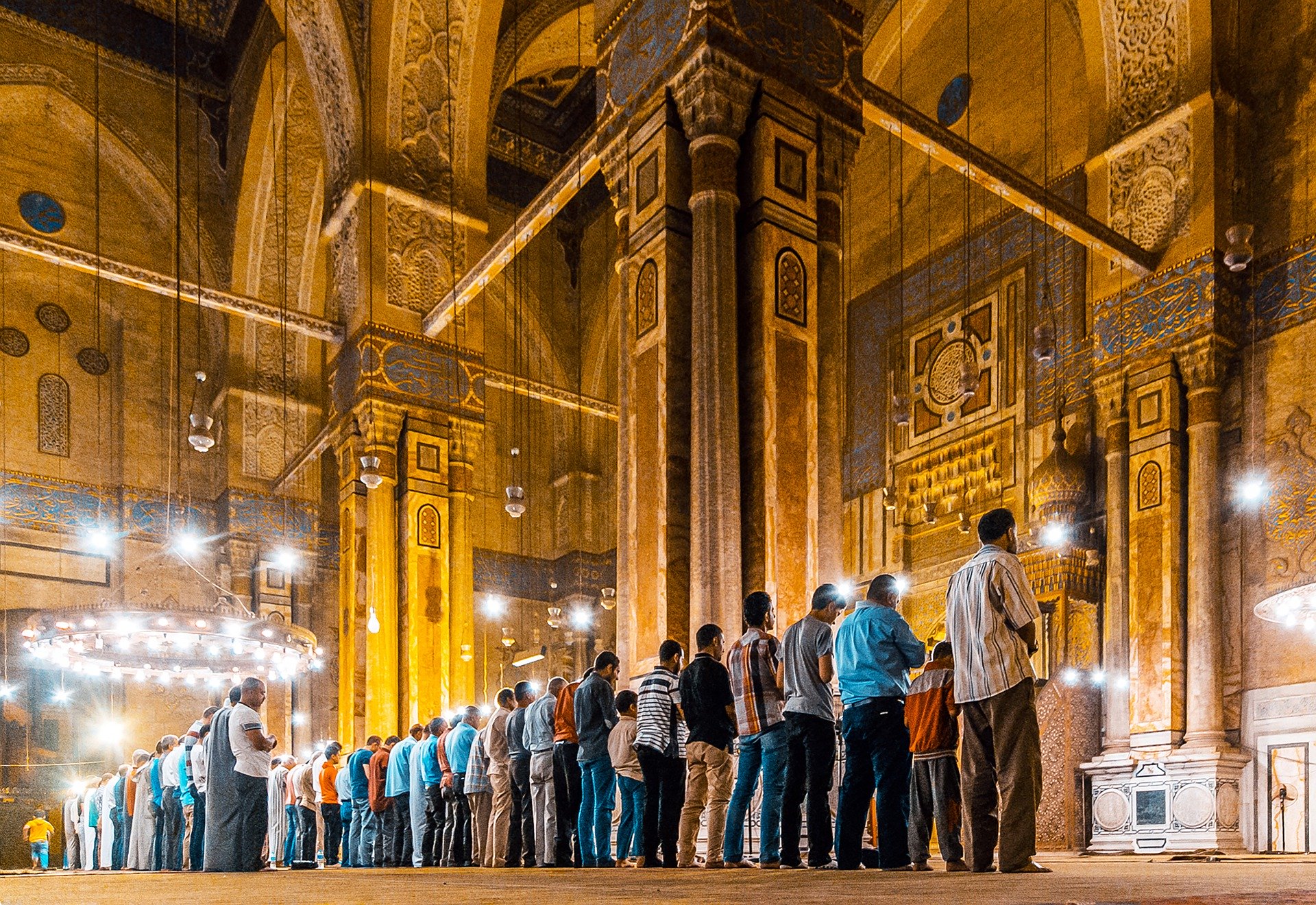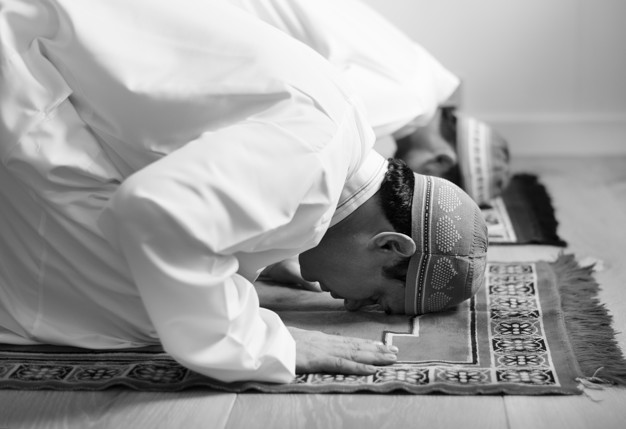8 Spicy Snack Recommendations that are Easy to Make at Home
The following spicy snack recommendations come with recipes if you want to make them at home. That way, you don't have to buy them if you suddenly want to eat spicy seblak or chicken feet.

Kapanlagi.com - Mandatory prayer is one of the worship that Allah SWT commanded for Muslims to perform. The command to perform mandatory prayers is even mentioned in the Quranic verses and hadiths. Therefore, understanding the mandatory prayer recitation order along with its procedure is necessary to perfect the worship being carried out.
READ ALSO: Read the intention of 5 mandatory prayers along with its meaning and pillars
Mandatory prayers consist of five times, namely Fajr, Dhuhr, Asr, Maghrib, and Isha. This mandatory worship is the second pillar of Islam that must be carried out by Muslims. Because prayer is mentioned in several verses and hadiths as the first act that is calculated or accounted for. Therefore, maintaining mandatory prayers is necessary to obtain grace and blessings from Allah SWT.
READ ALSO: Know the lyrics of Sholawat Badar and its meaning for the Prophet Muhammad SAW
Meanwhile, to perform mandatory prayers, there is a procedure that needs to be understood along with the mandatory prayer recitation order. The mandatory prayer recitation order starts with the intention and ends with the salam recitation.
The procedure for prayer must be done in order so that the prayer can be perfect according to its guidance.As for a complete explanation of the order of obligatory prayer readings complete with the procedures, you can read the review below which has been summarized by kapanlagi.com from various sources.

(credit: freepik.com)
As in the previous review, obligatory prayers consist of five times, each prayer has its own intention reading. In this case, the intention is the first prayer reading sequence that Muslims need to do before starting the next prayer series. As for the first prayer reading sequence, namely the intention, you can read the following review.
- Intention for Subuh prayer:
"Usholli fardha shubhi rak'ataini mustaqbilal qiblati adaa 'an lillaahi ta'aala."
Meaning: "I intend to pray fardu subuh, two rakats, facing the qibla, on time, for Allah ta'ala."
- Intention for Dzuhur prayer:
"Usholli fardha dzuhri arba'a raka'aatin mustaqbilal qiblati adaa'an lillaahi ta'aala."
Meaning: "I intend to pray fardu dzuhur, four rakats, facing the qibla, on time, for Allah ta'ala."
- Intention for Ashar prayer:
"Usholli fardha 'ashri arba'a raka'aatin mustaqbilal qiblati adaa'an lillaahi ta'aala."
Meaning: "I intend to pray fardu ashar, four rakats, facing the qibla, on time, for Allah ta'ala."
- Intention for Maghrib prayer:
"Usholli fardha maghribi tsalaatsa raka'aatin mustaqbilal qiblati adaa'an lillaahi ta'aala."
Meaning: "I intend to pray fardu maghrib, three rakats, facing the qibla, on time, for Allah ta'ala."
- Intention for Isya prayer:
"Usholli fardha 'isyaa'i arba'a raka'aatin mustaqbilal qiblati adaa'an lillaahi ta'aala."
Meaning: "I intend to pray fardu isya, four rakats, facing the qibla, on time, for Allah ta'ala."

(credit: pixabay.com)
After reading the obligatory prayer intention according to the time it is performed, the next prayer reading order is to perform takbiratul ihram. In this case, when someone has said takbiratul ihram, it is recommended to really keep the prayer from things that invalidate the prayer such as eating, drinking, speaking outside of prayer readings, or making movements outside of prayer movements. To perform takbiratul ihram, one should raise both hands parallel to the ears while saying the phrase "Allahu Akbar".

(credit: freepik.com)
The next order of obligatory prayer readings is to recite the iftitah prayer. The iftitah prayer is a prayer that is recommended to be recited in prayer, both obligatory and sunnah. This iftitah prayer is recited after takbiratul ihram and before reciting Surah Al-Fatihah. There are several versions of the iftitah prayer that can be recited, one of which is as follows:
"Allaahu akbaru Kabiraa Walhamdulillaahi Katsiiraa, Wa Subhaanallaahi Bukratan Wa'ashiilaa, Innii Wajjahtu Wajhiya Lilladzii Fatharas Samaawaati Wal Ardha Haniifan Musliman Wamaa Anaa Minal Musyrikiin. Inna Shalaatii Wa Nusukii Wa Mahyaaya Wa Mamaatii Lillaahi Rabbil 'Aalamiina. Laa Syariikalahu Wa Bidzaalika Umirtu Wa Ana Minal Muslimiin."
Meaning: "Allah is the Greatest with the greatest, all praise is for Allah with much praise. Glorified be Allah in the morning and evening. Indeed, I turn my face to Allah who created the heavens and the earth with complete obedience or in a state of submission, and I am not one of those who associate partners with Him. Indeed, my prayer, my worship, my life, and my death are only for Allah, the Lord of the Universe, who has no partner. With that, I was commanded. And I am among the Muslims (those who surrender themselves)."
The next sequence of prayer is to read Surah Al-Fatihah. Surah Al-Fatihah is a mandatory recitation during prayer. If it is not read, the prayer is considered invalid. The recitation of Surah Al-Fatihah is as follows:
(1) In the name of Allah, the Most Gracious, the Most Merciful.
(2) All praise is due to Allah, the Lord of all the worlds.
(3) The Most Gracious, the Most Merciful.
(4) Master of the Day of Judgment.
(5) You alone we worship, and You alone we ask for help.
(6) Guide us to the straight path.
(7) The path of those whom You have favored, not of those who have earned Your anger nor of those who go astray.
Meaning:
"In the name of Allah, the Most Gracious, the Most Merciful. All praise is due to Allah, the Lord of all the worlds, the Most Gracious, the Most Merciful, the Owner of the Day of Judgment. You alone we worship, and You alone we ask for help. Guide us to the straight path, the path of those whom You have favored, not of those who have earned Your anger nor of those who go astray."

(credit: freepik.com)
The next mandatory prayer sequence is to read short surahs in the Quran. You can choose a number of short surahs in the Quran, except for Surah Al-Fatihah. For example, you can read Surah An-Nas, Surah Al-Ikhlas, Surah Al-Humazah, and so on.
However, if the number of prayer cycles is four, then the recitation of short surahs is only read in the first and second cycles. Whereas if the prayer consists of three cycles, then it is read in the first and second cycles. And if it consists of two cycles, then it is read in the first and second cycles.
The next sequence of prayer is performing rukuk. Rukuk is a prayer movement by bowing down and holding both knees at a 45-degree angle. When performing rukuk, there is a prayer that needs to be recited. In this case, rukuk is performed after saying takbir but before performing i'tidal. The following is the recitation of rukuk in prayer,
"Subhaana robbiyal 'adhiimi wabihamdih." (3x)
Meaning: "Glory be to my Lord, the Great, and all praise is due to Him."
After performing rukuk, the next sequence of prayer is performing i'tidal. I'tidal is a prayer movement performed after standing up from rukuk and before prostration. I'tidal is done by raising both hands as if performing takbiratul ihram. The recitation of i'tidal that needs to be recited in prayer is,
"Robbanaa lakal hamdu mil us samawaati wamil ul ardhi wamil u maa syi'ta min syain ba'du."
Meaning: "Our Lord, all praise is due to You, filling the heavens, the earth, and whatever else You will after that."

(credit: freepik.com)
The next sequence in prayer is sujud. Sujud is performed by placing the head and both palms on the sajadah. When sujud is performed, there is a recitation that needs to be read as one of the requirements for valid prayer, which is:
"Subhaana rabbiyal a'la wa bihamdihi." (3x)
Meaning: "Glory be to my Lord, the Most High, and praise be to Him."
The next step is to sit between two sujud after performing the first sujud but before performing the second sujud. When sitting between two sujud, there is a prayer recitation that must be read. The prayer recitation when sitting between two sujud is as follows:
"Rabighfirlii, Warhamnii, Wajburnii, Warfa'ni, Warzuqnii, Wahdini, Wa'aafinii, Wa'fuannii."
Meaning: "O Allah, forgive me, have mercy on me, mend me, grant me sustenance, raise my rank, guide me, and forgive me."

(credit: freepik.com)
The next sequence in prayer is to perform the tasyahud awal, which is usually located in the second rakaat of obligatory prayer consisting of three or four rakaat. The recitation for the tasyahud awal is as follows:
"Attahiyyatul mubarakaatus salawatut tayyibatu lillah. Assalamu alaika ayyuhan nabiyyu warahmatullahi wabarakatuh. Assalamu alaina wa ala ibadillahis salihin. Asyhadu alla ilaha illallah. Wa asyhadu anna muhammadar rasulullah. Allahumma salli ala sayyidina muhammad."
Meaning: "All glory, blessing, mercy, and goodness belong to Allah. May peace, mercy, and blessings be upon you, O Prophet. May peace (also) be upon us and the righteous servants of Allah. I bear witness that there is no god but Allah, and I bear witness that Muhammad is the Messenger of Allah. Bestow your blessings upon our leader, Prophet Muhammad."
After reading the first tasyahud reading, then you can do the final tasyahud. The reading for the final tasyahud is as follows.
"All compliments, blessed words, prayers, and good deeds are for Allah. Peace be upon you, O Prophet, and the mercy of Allah and His blessings. Peace be upon us and upon the righteous servants of Allah. I bear witness that there is no god but Allah, and I bear witness that Muhammad is His servant and messenger. O Allah, send prayers upon our leader Muhammad and upon the family of our leader Muhammad, as You sent prayers upon our leader Ibrahim. And upon the family of our leader Ibrahim. And bless our leader Muhammad and the family of our leader Muhammad, as You blessed our leader Ibrahim and the family of our leader Ibrahim. You are indeed praiseworthy and glorious."
Meaning: "All compliments, blessed words, prayers, and good deeds are for Allah. May peace be bestowed upon you, O Prophet, and the mercy of Allah and His blessings. May peace be bestowed upon us and upon all righteous servants of Allah. I bear witness that there is no god but Allah, and I bear witness that Muhammad is His servant and messenger. O Allah, send prayers upon our leader Muhammad and upon the family of our leader Muhammad, as You sent prayers upon our leader Ibrahim. And bless our leader Muhammad and the family of our leader Muhammad, as You blessed our leader Ibrahim and the family of our leader Ibrahim. You are indeed praiseworthy and glorious."

(credit: freepik.com)
The last sequence of prayer is performing the salam. Salam can be done by turning to the right first while saying salam and then turning to the left while saying salam. The reading of the salam is as follows,
"Assalaamu'alaikum warohmatullooh."
Meaning: "May peace and mercy of Allah be upon you all."

(credit: freepik.com)
After understanding the order of reading the obligatory prayer, the procedure for performing this prayer is adjusted to the number of rak'ahs performed. If the obligatory prayer consists of four rak'ahs, such as Dhuhr, Asr, and Isha, the procedure is as follows.
- Recite the intention for prayer.
- Say Takbiratul Ihram.
- Recite the opening supplication (dua iftitah).
- Recite Surah Al-Fatihah.
- Recite a Surah from the Quran.
- Perform Rukuk (bowing).
- Stand up straight after Rukuk.
- Perform Sujud (prostration).
- Sit between the two prostrations.
- Perform Sujud (prostration) again.
- Stand up to perform the second rak'ah.
- The procedure is the same as the first rak'ah, except that the second rak'ah includes the early Tashahhud after the second Sujud.
- Then stand up again to perform the third rak'ah.
- The procedure is the same as the first rak'ah, without reciting a short Surah from the Quran.
- Then stand up again to perform the fourth rak'ah.
- The procedure is the same as the first rak'ah, but without reciting a short Surah from the Quran, except that it includes the final Tashahhud after the second Sujud.
- Conclude with the Salam in the fourth rak'ah.
The procedure for performing three rak'ahs in Maghrib prayer is as follows:
- Recite the intention for prayer.
- Say Takbiratul Ihram.
- Recite the opening supplication (dua iftitah).
- Recite Surah Al-Fatihah.
- Recite a Surah from the Quran.
- Perform Rukuk (bowing).
- Stand up straight after Rukuk.
- Perform Sujud (prostration).
- Sit between the two prostrations.
- Perform Sujud (prostration) again.
- Stand up to perform the second rak'ah.
- The procedure is the same as the first rak'ah, except that the second rak'ah includes the early Tashahhud after the second Sujud.
- Then stand up again to perform the third rak'ah.
- The procedure is the same as the first rak'ah, without reciting a short Surah from the Quran, except that it includes the final Tashahhud after the second Sujud.
- Conclude with the Salam in the third rak'ah.
The procedure for performing the two rak'ahs in Fajr prayer is as follows:
- Recite the intention for prayer.
- Say Takbiratul Ihram.
- Recite the opening supplication (dua iftitah).
- Recite Surah Al-Fatihah.
- Recite a Surah from the Quran.
- Perform Rukuk (bowing).
- Stand up straight after Rukuk.
- Perform Sujud (prostration).
- Sit between the two prostrations.
- Perform Sujud (prostration) again.
- Stand up to perform the second rak'ah.
- Recite Surah Al-Fatihah.
- Recite a Surah from the Quran.
- Perform Rukuk (bowing).
- Stand up straight after Rukuk.
- Before prostration, it is recommended to recite the Qunut supplication.
- After the Qunut supplication, say Takbir while raising both hands.
- Perform Sujud (prostration).
- Sit between the two prostrations.
- Perform the second Sujud (prostration).
- Then recite the final Tashahhud.
- Conclude with the Salam.
In order to be considered valid, there are several things that must be fulfilled when performing prayer. These things are called the conditions of validity in prayer. Therefore, in addition to understanding the meaning of prayer readings, we also need to know what the conditions of validity are. Because, if these conditions are not fulfilled, the prayer can become invalid.
Here are the conditions of validity in performing the prayer that every Muslim needs to know.
1. A person who performs prayer must be a Muslim
2. A person who performs prayer must also have reached puberty
3. A person who performs prayer must also be of sound mind
4. A person who performs prayer must be clean from impurities and filth, so it is obligatory to perform ablution
5. A person who performs prayer must understand the conditions, pillars, and sunnah of prayer
6. Prayer is performed facing the qiblah
7. Performed according to its time
In addition to the conditions for validity, there are also what are called pillars in prayer. Generally, the pillars of prayer are things that must or are obligatory to be done when establishing prayer. That means, if any part of the pillar is missed, the prayer can be considered invalid. Therefore, knowing what the pillars of prayer are is just as important as understanding the meaning of the prayer recitation.
Here are some pillars in prayer that every Muslim must know:
1. Standing for those who are able.
2. Reciting the intention.
3. Performing the takbiratul ihram.
4. Reciting Al Fatihah in every rakat.
5. Performing the bowing movement in a calm manner.
6. Performing iktidal after bowing and calm.
7. Performing two prostrations with calmness.
8. Orderly (in accordance with the sequence and nothing can be missed).
That is the complete mandatory prayer recitation order along with the procedure and its meaning. The explanation above can be a reference for you in performing mandatory prayers.
(kpl/gen/nlw)
Cobain For You Page (FYP) Yang kamu suka ada di sini,
lihat isinya
The following spicy snack recommendations come with recipes if you want to make them at home. That way, you don't have to buy them if you suddenly want to eat spicy seblak or chicken feet.
Therefore, from various sources, here is an explanation of what Haji Wada means, along with the law and basic principles of Haji Wada itself.
The meaning of kufur is often associated with a state opposite to faith. There are many kinds of kufur that you need to avoid. To understand the attitudes that need to be avoided, please read the explanation about the meaning of kufur, its types, and how to be grateful to Allah below.
Among the many popular Korean drama vocabulary, the word annyeong is often encountered. If you're a fan of Korean dramas, it doesn't hurt to know what annyeong means. Check it out here KLovers.
For the Indonesian nation, national awakening has significant meaning. Explain the importance of national awakening for the Indonesian nation. To make it easier, read the following review.
21+ film recommendations not only present hot scenes but also have thrilling genres like thriller to mystery. Check out the list of 21+ film recommendations here.
For KLovers who want to know about the meaning of Kopdar, it is compiled from various sources. Here is the meaning of Kopdar in the motor community along with other slang terms and benefits. Let's check it out KLovers.
Surat At Tin means Fig. In Surat At Tin, there are many meanings and special qualities. Here's an explanation for you, KLovers.
In the month of Ramadan, looking for trendy snacks to be used as iftar menus has become a habit. Well, if you are looking for recommendations for trendy snacks that are suitable for breaking the fast, just check out the interesting information below.
What are the latest recommendations for Korean films on Viu? Here are the latest recommendations for Korean films on Viu that can be a weekend entertainment choice. Let's check it out, KLovers.
These films have received great attention because the ideas conveyed are so profound and close to everyday reality. If you're curious, check out some of these recommended films on YouTube below.
Looking for recommendations for funny anime? Check out the list below.